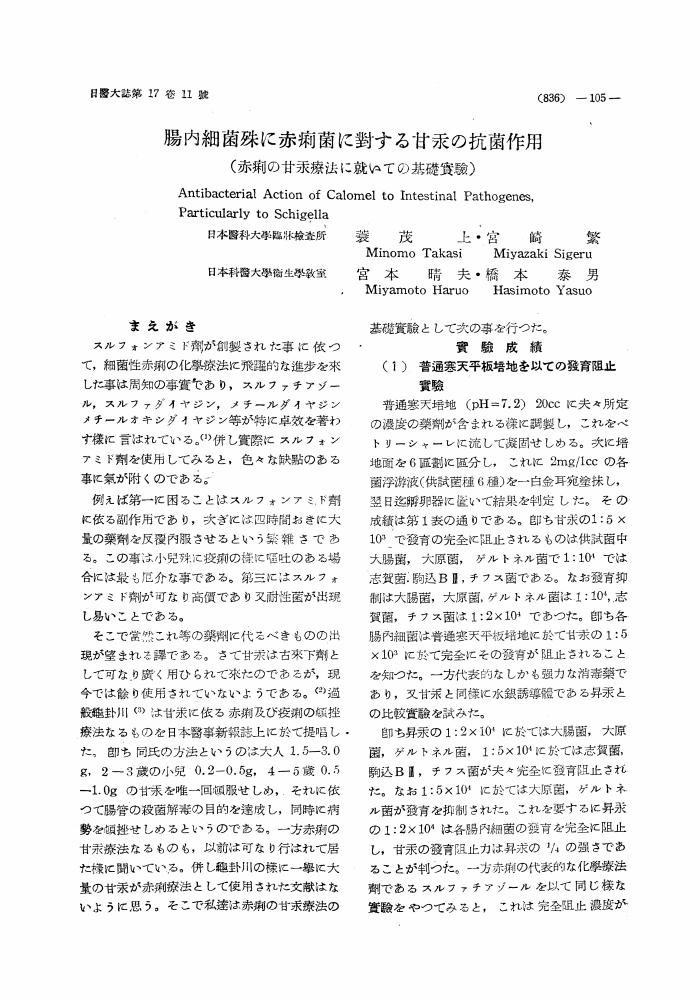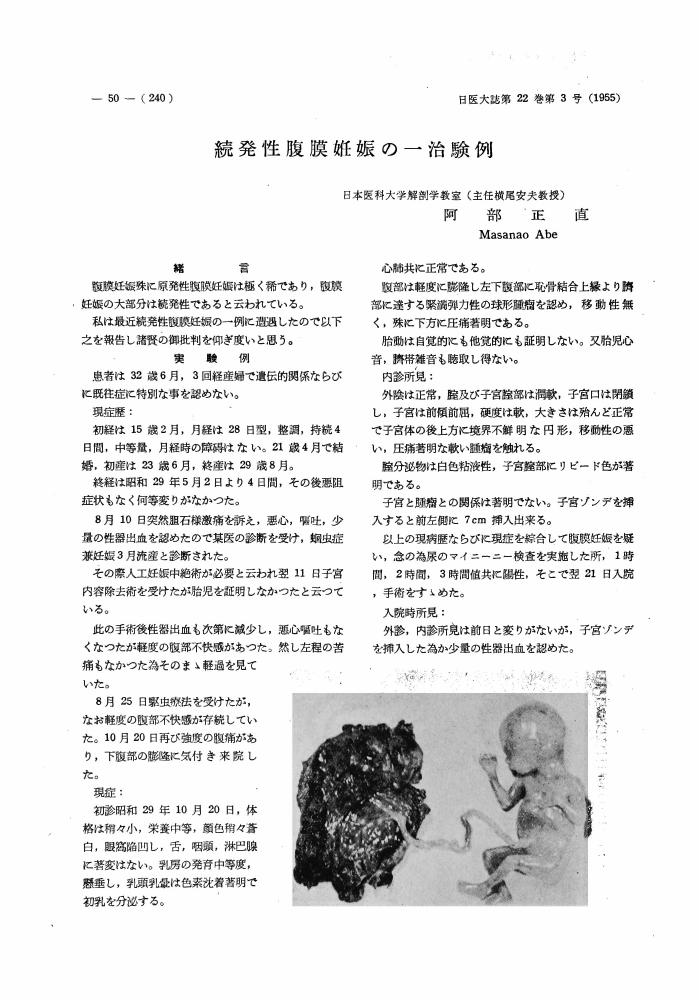2 0 0 0 OA 心電図起立試験に関する研究
- 著者
- 中村 祐久
- 出版者
- 日本医科大学医学会
- 雑誌
- 日本医科大学雑誌 (ISSN:00480444)
- 巻号頁・発行日
- vol.33, no.1, pp.33-46_2, 1966-02-15 (Released:2010-10-14)
- 参考文献数
- 46
2 0 0 0 OA 肩のいたみの臨床的研究
- 著者
- 柴田 正義
- 出版者
- 日本医科大学医学会
- 雑誌
- 日本医科大学雑誌 (ISSN:00480444)
- 巻号頁・発行日
- vol.39, no.1, pp.36-48, 1972-01-15 (Released:2010-10-14)
- 参考文献数
- 26
2 0 0 0 OA 本邦乳幼兒の身體發育に關する研究
2 0 0 0 OA 尿からの病原体検出の要領
- 著者
- 蓑茂 上
- 出版者
- 日本医科大学医学会
- 雑誌
- 日本医科大学雑誌 (ISSN:00480444)
- 巻号頁・発行日
- vol.24, no.11, pp.864-866, 1957-11-15 (Released:2009-07-10)
- 参考文献数
- 5
2 0 0 0 OA 本邦人体毛について
- 著者
- 白倉 毅
- 出版者
- 日本医科大学医学会
- 雑誌
- 日本医科大学雑誌 (ISSN:00480444)
- 巻号頁・発行日
- vol.27, no.6, pp.1041-1053, 1960-06-15 (Released:2010-10-14)
- 参考文献数
- 45
2 0 0 0 OA 頚管粘液の表面張力に関する研究
- 著者
- 松下 道雄
- 出版者
- 日本医科大学医学会
- 雑誌
- 日本医科大学雑誌 (ISSN:00480444)
- 巻号頁・発行日
- vol.40, no.3, pp.163-168_3, 1973-04-15 (Released:2010-10-14)
- 参考文献数
- 36
1 0 0 0 OA 正常新生児の泣き声に関する研究
- 著者
- 織田 利光
- 出版者
- 日本医科大学医学会
- 雑誌
- 日本医科大学雑誌 (ISSN:00480444)
- 巻号頁・発行日
- vol.55, no.1, pp.29-37, 1988-02-15 (Released:2009-12-04)
- 参考文献数
- 26
One hundred and thirty-eight cries of 56 infants were examined during first 14 days after birth. Crying in neonates was classified into three types of situational cry: hunger cry, discomfort cry and pain cry, and the temporal patterns of each type of cry were investigated on the basis of the parameters of cry duration and cry interval. The following results were obtained:1) In the case of the hunger cry, the cry duration was 0.69±0.31s, the cry interval 0.32±0.25s and the number of cries 9.3 ± 2.9 times/10s. The coefficient of cry duration variance showed the minimum value (=0.44) among the three types of cry, indicating that a constant cry duration was characteristic of the hunger cry. The coefficient of the cry interval variance (=0.79) was almost the same as that for the pain cry, but was lower than that for the discomfort cry. A rhythmical crying pattern was found in 72.7% of the cases of the hunger cry, which suggested a correlation between the hunger cry and a rhythmical crying pattern.2) In the discomfort cry, the cry duration was 0.82±0.62s, the cry interval 0.41±0.32s, and the number of cries 6.7±2.6 times/10s. The maximum coefficients of variance were seen for the cry duration and the cry interval, showing that this type of crying was characterized by large variations in the parameters. A rhythmical crying pattern was seen in only 19.0% of the cases of the discomfort cry.3) In the pain cry, the cry duration was 1.06±0.75s, the cry interval 0.39±0.92s and the number of cries 5.6±2.1 times/10s. The cry duration showed the longest value. A rhythmical crying pattern was seen in only 12.2%.4) The cry duration of the hunger cry gradually decreased during first 8 days after birth. The cry duration of the pain cry did not change during first 5 days after birth, but decreased during 6 to 8 days after birth. The cry duration of the discomfort cry showed no sequential changes in these periods.From the results, it was evident that there were characteristics in the cry durations and intervals and also were the crying patterns of neonates in accordance with the situation of them and the number of days after birth, so it was suggested that these can serve as points to distinguish when the mother hears the infant crying.
1 0 0 0 OA 特異な幻覚妄想を示したNarkolepsieの一例
1 0 0 0 OA アルコール疾患群間におけるCT所見による脳萎縮の比較
- 著者
- 石井 知行
- 出版者
- 日本医科大学医学会
- 雑誌
- 日本医科大学雑誌 (ISSN:00480444)
- 巻号頁・発行日
- vol.50, no.1, pp.96-116, 1983-02-15 (Released:2009-07-10)
- 参考文献数
- 89
The alcoholics were diagnosed and classified based on the criteria, offered at the Alcoholism Diagnostic Conference (1977) which was held under the auspices of the Ministry of Welfare, Japan. Grade of cerebral atrophy was estimated. Measurement items on the Computed Tomography (CT Scan) which contributed to discrimination among these groups were investigated simultaneously.The study consisted of seventy-five alcoholic patients and control group of ninety-four who were devoid of any evidence for alcoholism. Influential factors which were involved in cerebral atrophy of the alcoholic groups were investigated and factorial analysis was completed. There was a definite increase in cerebral atrophy during the aging process in patients with long term durations of drinking alcohol. There was a close correlation between age and duration of drin-king alcohol.Each group was compared by one-way classification analysis of variance on power normal distribution. There were significant differences between the alcoholics and the controls among all CT items. Enlargement of ventricles was recognized in the alcoholics. Also, significant differences were recognized according to the Ventricle index, the Evans' index, the Huckman number, and the width of Sylvian fissure between alcoholic dementia and other alcoholic psycho-ses. The degree of the enlargement of ventricles was extremely striking in alcoholic dementia.The results of one-way classification analysis of variance concerning the vertical diameter of the fourth ventricle showed a significant difference between the alcoholics and the controls. A tendency for cerebellar atrophy existed in the alcoholics.A regression analysis of CT items on age was performed. It was noticed that there was a parallel between the regression lines of the alcoholics and the controls, with the only difference being in the grade of CT items. Furthermore, another important finding was noticed in the 27-78 year range which indicated the same ratio between the alcoholics and the controls in the development of the enlargement of the ventricular systems (central atrophy). The mean value and standard deviation of each measurement item in each age stratum and each diagnostic group indicated that cerebral atrophy was much higher in the younger alcoholic group than in the aged control group. It was suggested that cerebral atrophy which developed as a result of the abnormal process of alcohol dependence appeared in the early stages of dependence and was more severe than atrophy caused by the physiological process of aging. In spite of continuous alcohol depen-dence, this atrophy did not make any rapid progress as anticipated in comparison with the control group. Once the initial atrophy developed, the rate of progression was the same in both the alcoholics and the controls. However, it was shown that cerebral atrophy started early in the initial stages of alcohol dependence, whereas physiological atrophy mainly started later in the natural process of aging.It was observed that a significant difference existed between the alcoholics and the controls after Kruskal-Wallis Test and Dunn-Multiple Comparison Test against the cortical sulcus (C.S) item. That is, cerebral cortical atrophy was seen in the alcoholics.After the results of canonical discriminant analysis against 9 CT items, the Ventricle index definitely contributed both in the discrimination between the alcoholics and the controls and in the discrimination between alcoholic dementia and other alcoholic psychoses. Furthermore, the horizontal diameter of the third ventricle contributed to the latter discrimination, while the Evans' index contributed to the former discrimination.
1 0 0 0 OA 主として頚椎過屈曲機転により生じた頚椎棘突起骨折の6例
1 0 0 0 OA 腸内細菌殊に赤痢菌に對する甘汞の抗菌作用
1 0 0 0 OA 慢性血清病型腎炎の際に糸球体に沈着する免疫複合物の性状について
- 著者
- 馬杉 洋三
- 出版者
- 日本医科大学医学会
- 雑誌
- 日本医科大学雑誌 (ISSN:00480444)
- 巻号頁・発行日
- vol.51, no.6, pp.649-656, 1984-12-15 (Released:2009-07-10)
- 参考文献数
- 23
- 著者
- 酒井 公範
- 出版者
- 日本医科大学医学会
- 雑誌
- 日本医科大学雑誌 (ISSN:00480444)
- 巻号頁・発行日
- vol.34, no.1, pp.42-58_3, 1967-02-15 (Released:2010-10-14)
- 参考文献数
- 42
1 0 0 0 OA 直腸温降下曲線法による死後経過時間推定
1 0 0 0 OA 止血剤ニ就テ
- 著者
- 林 春雄
- 出版者
- 日本医科大学医学会
- 雑誌
- 日本医科大学雑誌 (ISSN:00480444)
- 巻号頁・発行日
- vol.8, no.7, pp.917-920, 1937-07-15 (Released:2009-07-10)
1 0 0 0 OA 丸山ワクチンを使用し長期生存 (3年以上) した転移性肝癌60例について
1 0 0 0 OA 腎不全と電解質代謝
- 著者
- 越川 昭三
- 出版者
- 日本医科大学医学会
- 雑誌
- 日本医科大学雑誌 (ISSN:00480444)
- 巻号頁・発行日
- vol.47, no.1, pp.114-117, 1980-02-15 (Released:2010-12-22)
- 参考文献数
- 4
1 0 0 0 OA 自殺学入門
- 著者
- 黒澤 尚
- 出版者
- 日本医科大学医学会
- 雑誌
- 日本医科大学雑誌 (ISSN:00480444)
- 巻号頁・発行日
- vol.61, no.1, pp.2-8, 1994-02-15 (Released:2009-07-10)
- 参考文献数
- 10
1 0 0 0 OA 続発性腹膜妊娠の一治験例
- 著者
- 阿部 正直
- 出版者
- 日本医科大学医学会
- 雑誌
- 日本医科大学雑誌 (ISSN:00480444)
- 巻号頁・発行日
- vol.22, no.3, pp.240-242, 1955-03-15 (Released:2010-10-14)

















